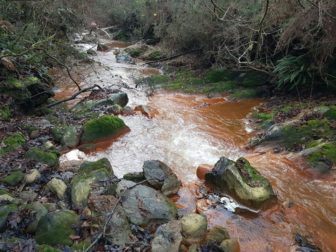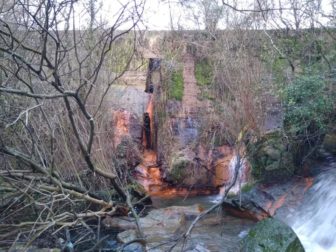In Lousame, Galicia, Spain, the San Finx tin and tungsten mine has a long history of toxic contamination and poses a risk of further contamination to downstream communities and ecosystems. Last week, during a Special Hearing of the European Parliament, the San Finx mine was singled out as an example of inadequate safety standards at European mines.
As Sacyr, the company that owns the mine, pushes to expand operations, it is seeking permits to discharge acid mine drainage from the mine pit and remove mine waste from two abandoned riverine tailings dams. The regional government has opened a public comment period for both proposals, but local communities worry the government is far too eager to approve the projects.

History of the San Finx Mine
The San Finx mine is made of 21 mining concessions in the Northeastern Spanish region of Galicia. It first opened in 1884 and continued in operation for almost 100 years. During WWII, the dictator Francisco Franco nationalized the mine and it became an important exporter of tungsten, used for weapons manufacturing for the Nazi war effort. From 1887 to 1943 the mine produced 5,672 tons of tin and tungsten, requiring the removal of an estimated 2 million tons of rock.
Two of its tailings dams were built by British engineers in 1928 and 1939 to store the mine waste, using a concrete riverine tailings dam design often seen in British colonies in the early 20th century. In 1990 the mine was abandoned as a consequence of falling metal prices and an ongoing criminal investigation into the company for pollution, but the owners maintained administrative functions until 2000 to prevent its mining permits from expiring.
In 2007, as climbing metal prices made previously non-profitable operations attractive to mining companies, the mine was purchased by Incremento Group Investor S.L. (IGI). However, IGI was unable to operate the mine profitably and declared bankruptcy in 2013, after receiving 2 million euros in subsidies. Finally, in 2015 the Spanish construction company Sacyr purchased San Finx and is seeking permits to operate until 2066. As a construction company, Sacyr doesn’t have operational mines anywhere in the world, although it does own dozens of exploration licenses at a number of sites in Spain.
A Dangerous Legacy
There is a history of environmental contamination associated with the San Finx mine and its tailings dams. In 1960 the damper on one of the largest dams failed, releasing thousands of cubic meters of mine waste into the river. The spill polluted the river and covered farmland downstream with tailings, contaminating the soil. According to the documentary, San Finx, 1960, fields used for farming were permanently damaged. As one community member told the filmmakers, “At harvest, half of the field was useless because it was full of sand from the mine, full of arsenic…” Testimony given by community members also contends that the fields were never fully remediated and that pollution continues to this day.
The current stability of the dams are also in question. Tailings dam expert Dr. Steven Emerman reviewed the dams in 2019 and found “some of the abandoned infrastructure has clear signs of internal liquefaction that, sooner or later, will imply a critical failure with an enormous environmental impact downstream and in the entire Muros and Noia estuary.” Dr. Emerman warned that the material behind the dam is unstable which could cause the dam to break or collapse without warning.

There has been chronic pollution from the tailings dams for decades. Downstream from tailings dam No. 1, cadmium levels are 93 times above the maximum allowable annual concentration average, based on the Environmental Quality Standards (EQS) established in European Parliament Directive 2000/60/EC, and copper and zinc values also exceed maximum allowable limits. Elevated cadmium levels (42.5 times the EQS) have been documented 1.5 km downstream. An average of approximately 50,000 litres of water and mine waste are released per hour into the nearby river, leading to levels of cadmium, copper and zinc above maximum allowable concentrations many kilometres downstream and significant contamination of an estuary protected under EU Natura 2000 status.
Long-term pollution and the threat of dam failure is particularly concerning because the Noia estuary, a mere 7 km away, is an important source of income for people in the region; thousands of people depend on gathering and farming shellfish in the estuary. A 2017 report by the Galician Water Authority warned that failure of the tailings dam would have “an important environmental impact” as a result of the downstream release of mining waste. Widespread contamination of the estuary, and the shellfish habitat, could last for decades and would have devastating impacts on fisherfolks’ health and livelihoods. As local shellfish gatherer Jose Manuel Romarís said, “Esa contaminación de las aguas se ha demostrado que ha llegado a la ría y nuestra principal preocupación es que acabe llegando a los bancos marisqueros.” [This water contamination has been shown to have traveled to the Ria [estuary] and our main concern is that it will get into the shellfish banks]. Ongoing heavy metal pollution discharge has already caused significant pollution in the estuary, as confirmed by recent studies of heavy metals in sediments of the inner estuary.
Corruption Undercuts Safety
Management of the San Finx tailings dams has also been fraught with corruption and bureaucratic manipulation.
In 2008, after IGI purchased the mining concessions for San Finx, the company deliberately left out any details surrounding two problematic tailings dams from the Mining Exploitation Project and Restoration Plan presented to the Directorate-General of Energy and Mines (DGEM). By excluding these tailings dams, the company attempted to erase them and its responsibility to address any associated problems. Local environmental organizations assert that “this absence seeks to release the concession holder from environmental responsibilities for hundreds of thousands of cubic meters of accumulated mining waste posing great danger to the environment and public health.“
When IGI sold their mining rights, and obligations, to Sacyr in 2015, the Galician Water Authority asked the new company to ensure the stability of the dams and register them with the competent authorities to correct the error. However, Sacyr responded that it had no responsibility for the dams because they were not listed in the 2009 Mining Exploitation Project. In 2020, the Galician Water Authority determined that Sacyr’s subsidiary was responsible for the abandoned tailings dams and a process to restore the area was initiated. Yet, remediation is currently blocked by the DGEM, which issued a report stating that the tailings dams were part of a small watermill and not the San Finx mine. This is not new: in 2019, the DGEM issued a report stating the dams were part of a non-existent hydroelectric facility.
Additionally, in 2009 the DGEM approved an application to restart mining at the site without an updated Environmental Impact Assessment and without considering treatment for perpetual pollution or the stability risks posed by the already existing tailings dams. This meant that local communities were not only denied access to information on the environmental and safety impacts of the renewed operations, they were denied the opportunity to present comments or oppose the project. By approving the project, DGEM ignored mining legislation and violated international treaties around access to information for affected communities. According to environmental groups that filed an Aarhus Convention complaint at the UNECE, “the Galician Regional Directorate General of Energy and Mines has insulated itself against public scrutiny and legal challenges by denying requests for public access to environmental information and public participation.”
The actions of the DGEM have caught the attention of public prosecutors and other authorities. In a 2018 letter, the Galician Ombudsman threatened to declare the attitude of DEGM “hostile and obstructive.” Later that year, his office began a formal investigation into its failure to provide the public access to information for multiple mine projects.
In 2017, the Public Prosecutor’s office filed a criminal case for corruption against the then DGEM Director-General, and additional proceedings were initiated in 2019. The criminal cases examine the permitting process, corruption and false documentation for the San Finx mine. The DGEM was required to turn over all administrative documents related to the mine. The director of the DGEM was forced to leave office in November of 2020 and the investigations into his actions and those of other officials are ongoing.
A Path Forward
Since 2016, local communities, particularly fisherfolk organizations, have made it clear they expect the government and the company to acknowledge the problem to prevent further pollution from acid mine drainage in the estuary, and to suspend mining operations until an environmental impact assessment is carried out. Such an assessment should include a permanent solution for the dams. In a 2017 report, the Galician Water Authority suggested tailings should be removed and the 1928 and 1939 dams demolished to restore the original valley and riverbed. The solution is feasible but costly.
Yet the cost of potential court convictions could be even higher. Public officials have willingly neglected recurring contamination and rushed headlong into approving mining projects, exposing themselves to legal risks. In the meantime, the risk of a critical failure and buildup of heavy metal pollution in the estuary area downstream remains a threat.
It is particularly concerning that the proposal to remove sludge from the tailings dam does not acknowledge that the materials are potentially toxic mine waste. To again avoid an environmental impact assessment, Sacyr’s subsidiary has ignored the chemical composition of the waste and will not adopt measures to prevent heavy metal pollution.
Fisherfolk and rural communities around the San Finx mine are creating their own solutions in the face of this legacy of contamination and corruption. Because the government and the mining company refuse to accept responsibility and much of the land around the mine is communal land, the surrounding villages have taken it on themselves to remediate the area. They have filled in abandoned mine pits, and reforested and restored contaminated land. In 2016, 10 hectares of common woodlands in the village of Froxán, one of communities affected by the mine, were burned in what villagers believe was an intentionally set forest fire connected to the mining conflict. In response, Froxán and other villages surrounding the mine worked to establish UN Indigenous and Community Conserved Area status, and are formally recognized as territories and areas conserved by indigenous peoples and local communities.
In the estuary, fisherfolk guilds have brought a joint proposal to UNESCO with Chile’s Corporación Nacional de Mujeres en la Pesca Artesanal [National Corporation of Women in Artisanal Fishing] to declare artisanal shellfish gathering a World Intangible Cultural Heritage. Communities have also begun working with local schools to teach children about the impacts of mining and to demand that municipal assemblies adopt resolutions to stop such impacts.
In response to the special public hearing at the EU on the environmental and social impacts of mining activity, Earthworks highlighted concerns over the lack of regulation of dangerous tailings storage facilities, like those at the San Finx mine and urged the European Parliament to “make good on its promise to fulfill the highest environmental and social standards worldwide and improve upon its mine waste regulations.”
Your Support Makes Our Work Possible
Earthworks helps families on the front lines of mining, drilling, and fracking. We use sound science to expose health, environmental, economic, social, and cultural impacts of mining and energy extraction. To support our efforts, please consider a tax-deductible donation today that will go toward our work reforming government policies, improving corporate practices, influencing investment decisions, and encouraging responsible materials sourcing and consumption.
